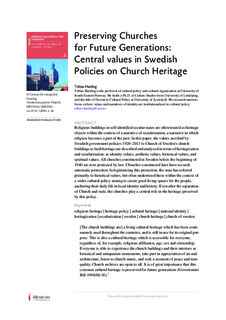Preserving Churches for Future Generations: Central values in Swedish Policies on Church Heritage
Journal article, Peer reviewed
Published version
Permanent lenke
http://hdl.handle.net/11250/2576801Utgivelsesdato
2018Metadata
Vis full innførselSamlinger
Originalversjon
Nordisk kulturpolitisk tidsskrift. 2018, 21 (1), 5-24.Sammendrag
Religious buildings in self-identified secular states are often treated as heritage objects within the context of a narrative of secularization, a narrative in which religion becomes a part of the past. In this paper, the values ascribed by Swedish government policies 1920–2013 to Church of Sweden's church buildings as built heritage are described and analyzed in terms of heritagization and secularization; as identity values, aesthetic values, historical values, and spiritual values. All churches constructed in Sweden before the beginning of 1940 are now protected by law. Churches constructed later have no such automatic protection. In legitimizing this protection, the state has referred primarily to historical values, but often understood these within the context of a wider cultural policy aiming to create good living spaces for the people, anchoring their daily life in local identity and history. Even after the separation of Church and state, the churches play a central role in the heritage preserved by this policy.

